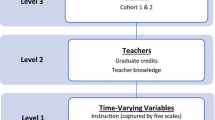Abstract
Change in mathematics teachers’ practice is often characterized as something that takes time and sustained intervention. In this article, I present the results of research that highlights a different kind of change—a profound change that takes place very quickly. Based on the analysis of 42 cases of such rapid and profound change, I also present a disaggregation of this phenomenon into five distinct mechanisms of change, each one rapid and profound. This disaggregation shows that not all changes, even when outwardly similar, are the same.
Similar content being viewed by others
Notes
Of course, what I notice is first and foremost predicated on what I find interesting. As a person who works in professional development settings I find all things associated with teacher change interesting.
In the settings in which I work my contact with teachers is discrete; constituted of a series of meetings at regular intervals. Teacher change in this setting is overwhelmingly observed to be incremental, gradual, and tentative, stretching out over several meetings and involving encouragement, planning, experimentation, and refinement. My use of the term rapid and profound is meant to describe changes that stand in stark contrast to this more usual form of change. So, for example, a teacher who is observed to change from no (or little) use of group work to ubiquitous use of group work wholly between two consecutive meetings without apparent trepidation is seen to have made a change that is rapid and profound.
References
Ball, D. (1988). Unlearning to teach mathematics. For the Learning of Mathematics, 8(1), 40–48.
Chapman, O. (2002). Belief structures and inservice high school mathematics teacher growth. In G. Leder, E. Pehkonen, & G. Törner (Eds.), Beliefs: A hidden variable in mathematics education (pp. 177–194). Dordrecht, Netherlands: Kluwer Academic Publishing.
Charmaz, K. (2006). Constructing grounded theory. London; Thousand Oaks, CA: Sage Publications.
Clandinin, D. J. (1992). Narrative and story in teacher education. In T. Russell & H. Munby (Eds.), Teachers and teaching from classroom to reflection (pp. 124–137). Bristol, PA: Falmer.
Fosnot, C. (1989). Enquiring teachers, enquiring learners: A constructivist approach for teaching. New York, NY: Teachers College Press.
Green, T. (1971). The activities of teaching. New York, NY: McGraw-Hill.
Greer, B. (2004). The growth of mathematics through conceptual restructuring. Learning and Instruction, 15(4), 541–548.
Jasper, B., & Taube, S. (2004). Action research of elementary teachers’ problem-solving skills before and after focused professional development. Teacher Education and Practice, 17(3), 299–310.
Leatham, K. (2006). Viewing mathematics teachers’ beliefs as sensible systems. Journal of Mathematics Teacher Education, 9(2), 91–102.
Leikin, R. (2006). Learning by teaching: The case of Sieve of Eratosthenes and one elementary school teacher. In R. Zazkis & S. Campbell (Eds.), Number theory in mathematics education: Perspectives and prospects (pp. 115–140). Mahwah, NJ: Erlbaum.
Liljedahl, P. (2008). Teachers’ insights into the relationship between beliefs and practice. In J. Maaß & W. Schlöglmann (Eds.), Beliefs and attitudes in mathematics education: New research results (pp. 33–44). Rotterdam, NL: Sense Publishers.
Liljedahl, P., Chernoff, E., & Zazkis, R. (2007). Interweaving mathematics and pedagogy in task design: A tale of one task. Journal for Mathematics Teacher Education, 10(4–6), 239–249.
Lord, B. (1994). Teachers’ professional development: Critical colleagueship and the roles of professional communities. In N. Cobb (Ed.), The future of education: Perspectives on national standards in America (pp. 175–204). New York, NY: The College Board.
Lortie, D. (1975). Schoolteacher: A sociological study. Chicago, IL: University of Chicago Press.
Mason, J. (2002). Researching your own practice: The discipline of noticing. New York, NY: Routledge.
McClain, K., & Cobb, P. (2004). The critical role of institutional context in teacher development. In M. J. Høines & A. B. Fuglestad (Eds.), Proceedings of 28th annual conference for the psychology of mathematics education (Vol. 3, pp. 281–288).
Morse, J. M., Stern, P. N., Corbin, J. M., Bowers, B., Charmaz, K., & Clarke, A. E. (2009). Developing grounded theory: The second generation. Walnut Creek, CA: Left Coast Press.
Piaget, J. (1968). Six psychological studies, Anita Tenzer (Trans). New York, NY: Vintage Books.
Skott, J. (2001). The emerging practices of novice teachers: The roles of his school mathematics images. Journal of Mathematics Teacher Education, 4(1), 3–28.
Stigler, J., & Hiebert, J. (1999). The teaching gap. Best ideas from the world’s teachers for improving education in the classroom. New York, NY: The Free Press.
Thompson, A. (1992). Teachers’ beliefs and conceptions: A synthesis of research. In D. A. Grouws (Ed.), Handbook of research on mathematics teaching and learning (pp. 127–146). New York: Macmillan.
Tirosh, D., & Tsamir, P. (2004). What can mathematics education gain from the conceptual change approach? And what can the conceptual change approach gain from its application to mathematics education? Learning and Instruction, 15(4), 535–540.
Vosniadou, S. (2006). Mathematics learning from a conceptual change point of view: Theoretical issues and educational implications. In J. Novotna, H. Moraova, M. Kratka, & N. Stehlikova (Eds.), Proceedings of 30th annual conference for the psychology of mathematics education (Vol. 1, pp. 163–165).
Vosniadou, S., & Verschaffel, L. (2004). Extending the conceptual change approach to mathematics learning and teaching. Learning and Instruction, 15(4), 445–451.
Wenger, E. (1998). Communities of practice. New York, NY: Cambridge University Press.
Author information
Authors and Affiliations
Corresponding author
Rights and permissions
About this article
Cite this article
Liljedahl, P. Noticing rapid and profound mathematics teacher change. J Math Teacher Educ 13, 411–423 (2010). https://doi.org/10.1007/s10857-010-9151-y
Published:
Issue Date:
DOI: https://doi.org/10.1007/s10857-010-9151-y




